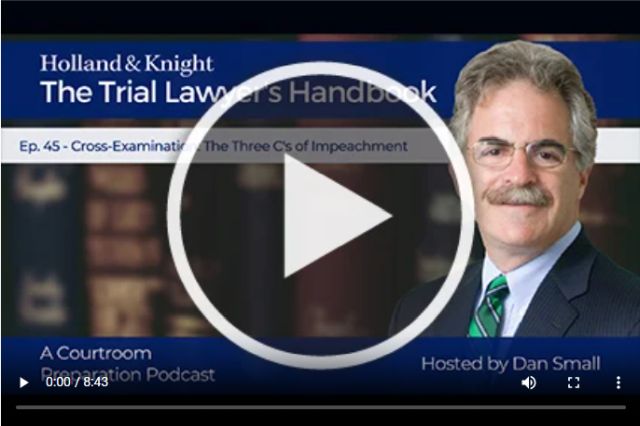In this episode of "The Trial Lawyer's Handbook" podcast series, litigation attorney Dan Small breaks down the "three C's of impeachment," drawing from his experience in a notable grain elevator explosion case. He highlights strategies including maintaining a poker face and waiting patiently for cross-examination to present a compelling argument. Mr. Small also emphasizes the importance of committing witnesses to their statements, crediting those statements for credibility and confronting inconsistencies, offering lawyers critical insights to sway the jury with clarity and drama.
Listen and subscribe on Amazon.
Listen and subscribe on Apple Podcasts.
Listen and subscribe on SoundCloud.
Listen and subscribe on Spotify.
Watch and subscribe on YouTube.
Podcast Transcript
Dan Small: The three C's of Impeachment. Could it be? Did you hear it right? You look discreetly at your co-counsel, and her efforts to mask a look of surprise and elation confirm it. The other side's key witness just directly contradicted something he said in his deposition. It's the kind of adrenaline rush that trial lawyers live for. Then a hint of panic creeps in. What do I do now?
The American Bar Association recently published a book of my actual trial stories called Lessons Learned from a Life on Trial, and one of the stories talks about the farmers' export grain elevator explosion case, which I prosecuted. Eighteen people were killed. The defense had a key witness who, during the chaos and confusion of the explosion, had given a statement to an OSHA investigator, a written sworn statement, which he had long since forgotten having given, and had completely changed his tune to make management happy. And so there I was, waiting to cross-examine this witness, knowing that I had in my pocket something no one else knew I had, which was his written sworn statement. So what do I do now?
First, don't risk offending the judge or jury or alerting opposing counsel by demonstrations of glee. Keep your poker face throughout the trial, no matter what. Be patient and wait for cross-examination. You will get your turn. And don't forget what you're trying to achieve. Trials are about persuasion — ideally, dramatic persuasion. You want to maximize the drama and clarity of the contradiction. That's where the three C's of impeachment come in. Commit, credit and confront.
Number one: Commit. Trials can be long and complicated. The grain elevator explosion case took over a month to try. By the time you get to that part of your cross-examination, the witness may have made the statement that you want to impeach hours or even days ago. Make it fresh again. Make it real again by repeating it at the same time. You want to lock the witness into the statement and prevent him from wiggling out. Once confronted by claiming confusion or mistake, the simplest way is just to ask on direct, "You testified X, correct?" Sometimes you don't care which version is true. You just want to show the jury the witness can't keep his story straight. However, if you believe that the version on direct, X, was false, don't let the witness repeat it without making that clear to the jury. Ask something like, "So your story on direct was X?" or, "So you want the jury to believe X?" Don't give up until a witness has either committed to or backed off from the statement.
Number two: Credit. Assuming the prior statement is the one you prefer, you want to give it as much weight and credibility as possible, and try to anticipate and block any effort to explain and waffle. To do that, you need to put the statement in context. For example, if the statement is from a deposition, ask about the deposition process itself. Establish that the witness had a chance to prepare, his lawyer was by his side, he took an oath to tell the truth, had a chance to review the transcript afterwards, and so on.
But a word of caution: Slow down and remember the big picture. Lawyers too often jump too fast to the document. The issue is not the impeaching document. The issue is whether the original statement was correct or whether the witness is a liar. Depending on the issue, many times you can confront the witness with the fact and then make a decision whether to bring in the prior statement. In other words, rather than rushing to ask, "Well, in your prior statement, you said the light was green?" Maybe you should start with the facts: "In fact, the light was green, wasn't it?" Think too, about sequencing. If the credit is going to take a while, you may want to put it first to avoid creating a long gap between commit and confront. If there are multiple uses for the prior statement, maybe credit it early. I've had cross-examinations in which the very first thing I did was credit the prior statement and leave a copy, burning a hole on the witness stand in front of the witness.
Number three: Confront. Now that you've locked in the current testimony and the weight of the prior statement, confront the witness with the inconsistency. Again, don't be in a hurry. It's not about the piece of paper. You don't have to show the document right away. Instead, you might ask, "In fact, in your sworn deposition, you said something completely different than your story today?" Where does that leave the witness? If he says yes, great. If he says no, that'll be a lot of fun. If he says, I don't remember, well, let's remind him. Those are the types of cross-examination questions that you love, questions where you really don't care what the witness answers. "In fact, in your sworn deposition, you said something completely different than your story today?" Don't paraphrase or summarize. Quote the prior statement precisely. If you do, whatever the answer is, you're happy. Yes? Great. You're on the point. No? Confront him. I don't recall? Find refreshing to confront effectively. Give the witness a copy. Display it to the jury if allowed. Then read it out loud and ask the witness if you read it correctly. By the way, this is your cross-examination. You should be in control. And if something needs to be read, you are the one who should read it. Then consider other ways to emphasize the prior statement. Do you want to try to offer it as an exhibit? To blow it up either electronically or on poster board by itself, or comparing the two statements? Technology in the courtroom creates even more potential for drama. Use the monitors. Use whatever is there. Underline or highlight the prior statement. Consider carefully the point you want to make or whether there even is a point. I once observed a lawyer go on at length impeaching a minor witness on a minor conflict from a prior statement. When I asked counsel later what was his theme with that witness, the answer was, "Oh, nothing, really. He didn't hurt me at all." Really? Then why impeach? Why not just say those magic words? "No questions, your honor."
Finally, remember that impeachment alone isn't the only goal. Under the right circumstances, you can turn a mere prior inconsistent statement into something much more a demonstration that your side, and by extension, you, the lawyer, is a credible and reliable source of the truth.
The content of this article is intended to provide a general guide to the subject matter. Specialist advice should be sought about your specific circumstances.


